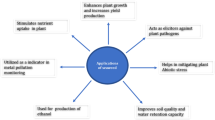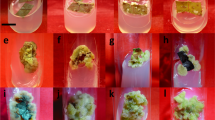Abstract
Grapes are known to synthesize resveratrol, a stilbene phytoalexin, associated with cancer chemopreventive activity and cardioprotection. The effect of ultrasound (US) abiotic elicitor treatments on trans-resveratrol content in Kalecik Karası fresh and frozen grape skin was determined. D-optimal point change design was used under RSM for the experimental design of US treatment. The optimization was solved with the help of the Pareto areas and the optimal input variable values were determined by the desirability function with fuzzy similar perceivable ratio method. The optimum conditions of US treatment for fresh grape skin were determined as follows: incubation time—24 h, US application method-(P01), US frequency—20 kHz, US treatment time—60 min and ultrasonic intensity (UI)—1.15 W cm−2. The trans-resveratrol content (0.18 ± 0.01 mg/g) in the untreated grape skin significantly increased with optimum US treatment (3.58 ± 0.08 mg/g), increasing production to 19.9 times.



Similar content being viewed by others
References
Ather M, Back JH, Tang X, Kim KH, Kopelovich L, Bickers DR, Kim AL (2007) Resveratrol: A review of preclinical studies for human cancer prevention. Toxicol Appl Pharmacol 224:274–283
Barton S, Bullock C, Weir D (1996) The effects of ultrasound on the activities of some glycosidase enzymes of industrial importance. Enzyme Microbial Technol 18:190–194
Becker JVW, Armstrong GO, Merwe MJ, Lambrechts MG, Vivier MA, Pretorius IS (2003) Metabolic engineering of Saccharomyces cerevisiae for the synthesis of the wine-related antioxidant resveratrol. FEMS Yeast Res 4:79–85
Bremner DH (1986) Chemical ultrasonics. Chem Br 22:633
Cordemans E (1991) Ultrasound. A new performance tool for the chemical industry. Chimicaoggi, November 17–20
Corre LL, Chalabi N, Delort L, Bingon YJ, Bernard-Gallon DJ (2005) Resveratrol and breast cancer chemoprevention: molecular mechanisms. Mol Nutr Food Res 49:462–471
Counet C, Callemien D, Collin S (2006) Chocolate and cocoa: new sources of trans-resveratrol and trans-pieced. Food Chem 98:649–657
Delmas D, Jannin B, Latruffe N (2005) Resveratrol: preventing properties against vascular alterations and aging. Mol Nutr Food Res 49:377–395
Derringer G, Suich R (1980) Simultaneous optimization of several response variables. J Qual Technol 12(4):214–219
Dong Z (2003) Molecular mechanism of the chemopreventive effect of resveratrol. Mutat Res 523(524):145–150
Eriksson L, Johansson E, Wikstrom C (1998) Mixture design–design generation PLS analysis, and model usage. Chemometr Intell Lab 43:1–24
Fan E, Lin S, Du D, Jia Y, Kang L, Zhang K (2011) Current separative strategies used for resveratrol determination from natural sources. Anal Methods 3:2454–2463
Hao HD, He LR (2004) Mechanisms of cardiovascular protection by resveratrol. J Med Food 7:290–298
Hasan MM, Bae H (2017) Molecules an overview of stress-induced resveratrol synthesis in grapes: perspectives for resveratrol-enriched grape products. Molecules. https://doi.org/10.3390/molecules22020294
Hasan MM, Baek KH (2013) Induction of resveratrol biosynthesis in grape skin and leaves by ultrasonication treatment. Korean J Hortic Sci Technol 31:496–502
Hasan MM, Yun HK, Kwak EJ, Baek KH (2014) Preparation of resveratrol-enriched grape juice from ultrasonication treated grape fruits. Ultrason Sonochem 21:729–734
ICH (2005) Validation of analytical procedures: text and methodology Q2 (R1). In: International conference on harmonization, Geneva, Switzerland, pp 11–12
Jeandet P, Breuil AC, Adrian M, Weston LA, Debord S, Meunier P, Maume G, Bessis R (1997) HPLC analysis of grapevine phytoalexins coupling photodiode array detection and fluorimetry. Anal Chem 69(24):5172–5177
Keller M, Steel CC, Creasy GL (2000) Stilbene accumulation in grapevine tissues: Developmental and environmental effects. In: XXV international horticultural congress, part 4: culture techniques with special emphasis on environmental implications ISHS Acta Horticulturae 514: 275–286
Newman DJ, Cragg GM (2020) Natural products as sources of new drugs over the nearly four decades from 01/1981 to 09/2019. J Nat Prod 83(3):770–803. https://doi.org/10.1021/acs.jnatprod.9b01285
Orallo F (2006) Comparative studies of the antioxidant effects of cis- and trans-resveratrol. Curr Med Chem 13(1):87–98
Potrebko I, Resurreccion AVA (2009) Effect of ultraviolet doses in combined ultraviolet-ultrasound treatments on trans-resveratrol and trans-pieced contents in sliced peanut kernels. J Agric Food Chem 57:7750–7756
Rudolf JR, Resurreccion AVA (2005) Elicitation of resveratrol in peanut kernels by application of abiotic stresses. J Agric Food Chem 53(26):10186–10192
Sales JM, Resurreccion AVA (2009) Maximising resveratrol and pieced contents in UV and ultrasound treated peanuts. Food Chem 11(7):674–680
Schmidlin L, Poutaraud A, Claudel P, Mestre P, Prado E, Santos-Rosa M (2008) A stress-inducible resveratrol O-methyltransferase involved in the biosynthesis of pterostilbene in grapevine. Plant Physiol 148:1630
Signorelli P, Ghidoni R (2005) Resveratrol as an anticancer nutrient: molecular basis, open questions, and promises. J Nutr Biochem 16:449–466
Sinisterra JV (1992) Application of ultrasound to biotechnology: an overview. Ultrasonics 30(3):180–185
Toma M, Fukutomi S, AsakuraY Koda S (2011) A calorimetric study of energy conversion efficiency of a sonochemical reactor at 500 kHz for organic solvents. Ultrason Sonochem 18(1):197–208
Trela BC, Waterhouse AL (1996) Resveratrol: isomeric molar absorptivities and stability. J Agric Food Chem 44:1253–1257
Wang L, Xu M, Liu C, Wang J, Xi H, Wu B, Loescher W, Duan W, Fan P, Li S (2013a) Resveratrols in grape berry skins and leaves in vitis germplasm. PLoS ONE 8(4):e61642. https://doi.org/10.1371/journalpone.0061642
Wang LJ, Ma L, Xi HF, Duan W, Wang JF, Li SH (2013b) Individual and combined effects of CaCl2 and UV-C on the biosynthesis of resveratrols in grape leaves and berry skins. J Agric Food Chem 61:7135–7141. https://doi.org/10.1021/jf401220m
Wu J, Lin L (2002) Ultrasound-induced stress responses of Panax ginseng cells: enzymatic browning and phenolics production. Biotechnol Prog 18:862–866
Funding
This research was supported by the Scientific Research Projects Coordination Unit of Ankara University Biotechnology Institute (Project number: 2005163).
Author information
Authors and Affiliations
Corresponding author
Ethics declarations
Conflict of interest
No potential conflict of interest was reported on behalf of all authors.
Additional information
Publisher's Note
Springer Nature remains neutral with regard to jurisdictional claims in published maps and institutional affiliations.
Rights and permissions
About this article
Cite this article
Erte, E., Vural, N., Mehmetoğlu, Ü. et al. Optimization of an abiotic elicitor (ultrasound) treatment conditions on trans-resveratrol production from Kalecik Karası (Vitis vinifera L.) grape skin. J Food Sci Technol 58, 2121–2132 (2021). https://doi.org/10.1007/s13197-020-04722-w
Revised:
Accepted:
Published:
Issue Date:
DOI: https://doi.org/10.1007/s13197-020-04722-w




